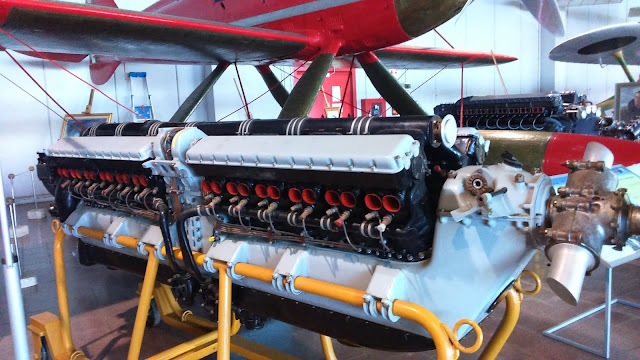Realizzato specificatamente per equipaggiare l'idrocorsa Macchi-Castoldi M.C.72 destinato a partecipare alla Coppa Schneider detiene il primato di essere il motore a pistoni più potente mai realizzato in Italia.
Storia
Sviluppo
Dopo la vittoria da parte degli idrocorsa britannici delle edizioni della Coppa Schneider del 1927 e 1929, la possibilità che gli inglesi conquistassero il Trofeo era concreta e penalizzante nei confronti dell'industria aeronautica italiana e per il prestigio del Regime fascista. Il Ministero dell'Aeronautica emanò quindi una specifica per la realizzazione di un idrocorsa ad elevatissime prestazioni da destinare all'edizione del 1931. Alla richiesta risposero l'Aeronautica Macchi, alla quale venne affidata la costruzione della cellula, e la Fiat Aviazione.
Le specifiche che riguardavano la propulsione erano molto esigenti; il nuovo motore avrebbe dovuto erogare una potenza di 2 300 CV (1 692 kW), aumentabile in tempi brevi a 2 800 CV (2 059 kW), un peso non superiore agli 840 kg ed un consumo specifico massimo di 250 g/CVh.
Per risolvere il problema l'ingegner Tranquillo Zerbi, incaricato della sua progettazione, decise di sfruttare l'esperienza acquisita nella messa a punto del motore AS.5, un 12 cilindri a V realizzato per equipaggiare l'idrocorsa Fiat C.29. Il motore, arrivato al massimo sviluppo consentito, era impossibilitato a raggiungere le prestazioni del suo concorrente britannico, il Rolls-Royce R, che con i suoi 1 900 hp (1 417 kW) equipaggiava il Supermarine S.6 per cui Zerbi escogitò una soluzione inedita, l'abbinamento di due unità separate che complessivamente avrebbero erogato la potenza richiesta.
Particolarità
I 24 cilindri erano disposti a V, in due gruppi da 12 cilindri ciascuno, separati da una doppia camera intermedia che conteneva i ruotismi. I due gruppi di ruotismi erano meccanicamente indipendenti, ciascuno col proprio albero motore e riduttore a ingranaggi che azionava il proprio albero d'elica. I due alberi d'elica, coassiali e posizionati al centro della V dei cilindri, terminavano ciascuno col proprio mozzo.
Velivoli utilizzatori: Italia - Macchi-Castoldi M.C.72 (idrocorsa).
ENGLISH
The Fiat AS.6 was a liquid-cooled 24-cylinder V-engine for racing aircraft built by the Italian company Fiat Aviazione in the 1930s.
Specifically designed to equip the Macchi-Castoldi M.C.72 hydrocorsa intended to participate in the Schneider Cup, it holds the record of being the most powerful piston engine ever built in Italy.
History
Development
After the British hydro race won the 1927 and 1929 Schneider Cup editions, the possibility of the British winning the Trophy was real and penalising for the Italian aeronautics industry and for the prestige of the Fascist regime. The Ministry of Aeronautics then issued a specification for the creation of a high-performance hydrocorsa to be allocated to the 1931 edition. The request was answered by Aeronautica Macchi, which was entrusted with the construction of the airframe, and Fiat Aviazione.
The specifications regarding the propulsion were very demanding; the new engine should have produced a power of 2 300 hp (1 692 kW), which could be quickly increased to 2 800 hp (2 059 kW), a weight not exceeding 840 kg and a maximum specific consumption of 250 g / hp.
To solve the problem, Tranquillo Zerbi, the engineer in charge of its design, decided to take advantage of the experience gained in the development of the AS.5 engine, a 12-cylinder V engine designed to equip the Fiat C.29 hydrocorsa. The engine, which had reached its maximum allowed development, was unable to reach the performance of its British competitor, the Rolls-Royce R, which with its 1 900 hp (1 417 kW) equipped the Supermarine S.6 so Zerbi came up with a new solution, the combination of two separate units that would provide the total power required.
Particularity
The 24 cylinders were arranged in a V shape, in two groups of 12 cylinders each, separated by a double intermediate chamber containing the gears. The two groups of gears were mechanically independent, each with its own motor shaft and gearbox that propelled its propeller shaft. The two propeller shafts, coaxial and positioned in the centre of the V of the cylinders, each ended with its own hub.
User aircraft
Italy - Macchi-Castoldi M.C.72 (hydro running).
(Web, Google, Wikipedia, You Tube)














Nessun commento:
Posta un commento
Nota. Solo i membri di questo blog possono postare un commento.